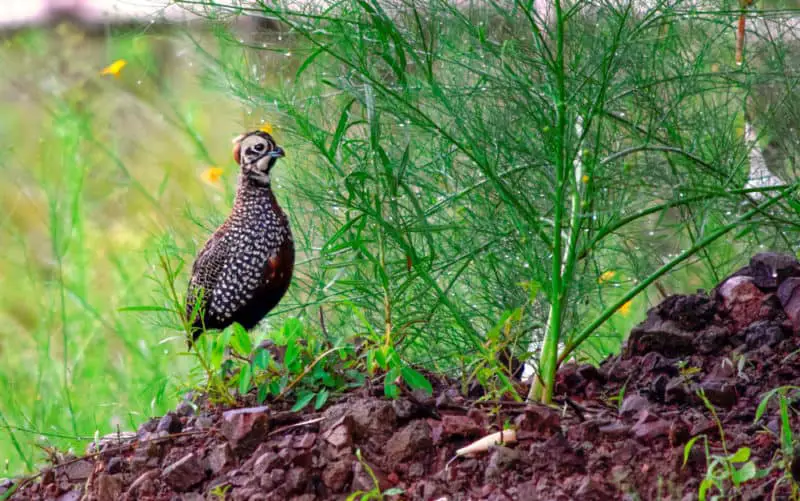The Montezuma Quail is a member of the Odontophoridae family, which includes all-new world quails. These birds are also called the Mearns quail in honor of Dr. Edgar A. Mearns. Dr. Mearns was an army surgeon/ ornithologist and naturalist in Arizona territory in the 1880s. He cataloged and named them. However, the bird had already been cataloged and named Montezuma quail by John Gould in 1830.
What do Montezuma Quail look like?
Montezuma quail are similar in build to other new world quail. They are short in stature with plump round bodies. On average, adult birds are 8 to 9 inches (20 to 23 cm) long and weigh from 6.2 to 6.9 ounces (176 to 196 grams).
Males have a brilliant black and white swirled mask pattern on their faces. Additionally, they have white dots over a black background along their sides. Females of the species are more conservatively colored. They have varying shades of brown on their faces instead. Both sexes have bluish-colored beaks. Montezuma quail lack the prominent top knots that other quail species have. However, both sexes have a tan plume that lies flat from the back of their head down the back of their neck.
Montezuma Quail Range
The majority of the range that Montezuma quail inhabit lies in Mexico. It begins in the Mexican state of Oaxaca and extends north through the interior of the country along the Sierra Madre and across the border into the United States. In the U.S, Montezuma Quail live in Arizona, New Mexico, and Texas. There are approximately 1.5 million Montezuma quail. Ninety percent of them live in Mexico, while ten percent live in the United States. Source
In Arizona
Look for Montezuma Quail in the southeastern corner of the state. More specifically, look in the Chiricahua, Escudilla Tumacacori, Santa Catalina, Rincon, Huachuca , Whetstone, Patagonia and Santa Rita Mountains. Source
In New Mexico
Montezuma quail inhabit the southern end of New Mexico. You can find them in Catron Sucorro, Lincoln, Otero, Hidalgo, Luna, Sierra, Donna Anna, Chaves, Torrance counties.
In Texas
Unlike Arizona and New Mexico, the state of Texas doesn’t allow hunting for Montezuma Quail. Their population has declined significantly in the state over the last 150 years. There are still populations of them in the mountains and basins of the Trans-Pecos region and Edwards Plateau.
Montezuma Quail Habitat
Montezuma quail live in perennial grassland habitat on the bottom 1/3 of the slopes of desert mountains in the southwestern United States and Mexico. They live in mixed pinyon/juniper to oak forests a large percentage of the time but can also be found at elevations where pines grow. In fact, they live at elevations over 10,000 feet in rare instances.
Their population viability is very sensitive to overgrazing by livestock. They need a habitat greater than 50% covered by grass that is at least a foot tall in which to nest and to hide from their predators in and if it isn’t there, they die out quickly.
A lot of the territory they live in is dependent on monsoonal rains that come in the late summer. In the optimal Montezuma Quail habitat, late summer grasses need at least 10 inches of monsoonal rain to do well. Consequently, when the monsoon weather pattern doesn’t materialize, the dependent grass won’t spring up in that year. Resultantly, the Montezuma Quail population will crash due to the lack of available cover. Source
Montezuma Quail Behavior
Feeding behavior
Montezuma Quail, in general, do not form large coveys like other quail species do. They generally feed in pairs or small groups consisting of their immediate family members.
These birds are ground feeders. They obtain a large share of their daily nutrition scratching in the soil. The birds have elongated claws that are specially adapted for digging. Their diet is comprised of bulbs, tubers, acorns, and grass seeds. They also eat insects, particularly in the summer when they are more abundant.
These birds have the ability to survive on no water other than what they derive from the food that they take in.
They also don’t do a great deal of moving around as they forage from day to day. A typical Montezuma quail pair or covey will end up within 50 meters of the area they spent the previous day in.
Hiding behavior
Montezuma quail fly from danger only as a last resort. Their first reaction is to run for the thickest cover they can find and then crouch low against the ground and become motionless. Their seemingly bizarre markings make perfect camouflage against the background they live in. They’re so reluctant to move that they sometimes allow the threat, whether that be man or animal, to approach within feet before they fly. This makes them extremely difficult to locate without a dog but also can be their undoing. Sometimes they can be caught by hand.
This is a large part of the reason that they’re so vulnerable to drought or overgrazing. If there’s no grass to give them cover, they become easy pickings for whatever predators that come along.
Mating behavior
Montezuma quail are generally monogamous; however, sometimes, in years when their environment is especially productive such as years with abundant rain, females will mate with two males and lay two clutches of eggs in two separate nests. Each male takes on the reasonability of incubating his set of eggs.
Montezuma quail build nests that are covered dome-shaped structures with a single entrance. The structure’s interior measures around five and a half inches wide and slightly less than that in height.
Their clutch size varies from 2 to fifteen eggs. They incubate their eggs for 24 to 26 days. Their chicks are born covered in down. They leave the nest with their parents as soon as the clutch has fully hatched. They’ll remain with their parents for 6 to 7 months. Source
Also see:


